The Killer SEO Guide for B2B Companies: Strategies & Tools
Wednesday,
Any chance you Google searched for something related to B2B SEO and found yourself here..?
This is exactly what you will learn in this guide: how your company can rank higher in organic search results for your relevant keywords.

This article will cover:
SEO Basics
Advanced Strategies
Our explanation on the basic and advanced strategies of B2B SEO will include the steps to maximize the potential of Search Engine Optimization as a non-paid traffic channel in addition to the tools we use, as a B2B SEO agency.
THE DIFFERENCE BETWEEN B2B & B2C SEO
Before we go down to the nuts and bolts of B2B SEO, we need to differentiate it from B2C SEO, as the B2B space has its own unique requirements and considerations.
Here are the parameters we set for this guide to define the difference between the B2B and B2C buyer journey:
| B2B | B2C | |
| Price of Product | High | Low |
| Decision Makers | Few | Just One |
| Buying Cycle | Long | Short |
Now let’s see how each parameter affects the SEO strategy.
Price
Since most B2B products cost more than B2C products, the value of a B2B product search is higher than a B2C product search.
It’s all about Search Profit Potential – what the company stands to profit if the user completes the purchase.
If you’re searching for a pair of running shoes the search profit potential is up to $300.
If you’re searching for a marketing automation solution the search profit potential can be $3000 a month.
Decision Makers
There are various decision makers in a company that are involved in a B2B purchase decision. Therefore, each will have their search focus on a different aspect of the product.
Let’s take marketing automation software as an example again.
Accounting will search for the financial aspects:
“marketing automation software cost”
or
“marketing automation software price”
IT will search for technical aspects:
“marketing automation software integration”
or
“marketing automation software compatibility”
Marketing will search for growth:
“marketing automation software for lead generation”
In B2C, a single shopper makes the purchase decision in most cases.
Buying Cycle / Buyer Journey
Buying cycle stages for both B2C and B2B are:
- Identifying a problem or a need
- Researching for possible solutions, comparing between the different products available
- Reaching a decision and making the purchase
However, in a B2B buying cycle, the second stage – researching & comparing – is multiplied by the number of the decision makers within the company that are involved.
This is why the duration of the B2B buying cycle is longer.
It makes sense that a more consequential decision requires longer deliberation.
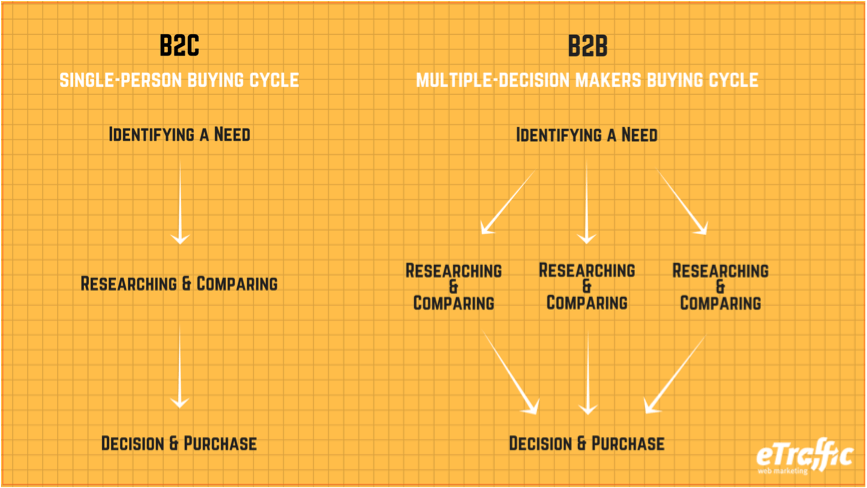
Now that we established the difference between B2B and B2C purchasing processes, we can start laying down the foundations of a B2B SEO strategy.
THE ROLE KEYWORDS IN B2B SEARCH MARKETING
A Business to Business SEO strategy deals with many sets of keywords and search terms to target different decision makers at the different stages of the buyer journey.
Keywords Are Questions and their Answers
The starting point of every SEO strategy is keyword research.
Keyword research is understanding the questions your potential customers are asking themselves, and breaking them down to search queries – what potential customers actually type in the search box.
B2B purchase-driven searches are very specific.
They can be about specs, features and performance, value, benefit and ROI, cost – of product itself and running costs – maintenance, support, troubleshooting; the list goes on and varies with every product.
Keyword research helps you decide which keywords to target. Obviously, you can’t target all of your keywords of interest; unless you have unlimited resources.
BEST PRACTICES FOR WEBSITE STRUCTURE
Your website plays a crucial role in your SEO strategy. It needs to include all the keywords and search terms you are targeting, organized in topical pages according to the different features of your product or service.
Search engines want to see that your website corresponds with your keyword and link building strategies.
This is how search engines value, and rank, your website and that’s why it’s important to practice SEO for a new website.
On-Page vs. Off-Page SEO
On-page SEO is the optimization of both the content and the source code (HTML) of a page on your website. Content optimization is including relevant keywords in the text and creating content that is comprehensive. Source code optimization is ensuring the code is indexed by search engines (totally technical, not worth explaining.)
Off-page optimization is creating relevant external links on third-party sites that point to a specific page on your website (more on link building below.)
The overarching goal of both these practices is to rank higher in search results for relevant terms, and thus drive more traffic to your website.
Website SEO Hierarchy
Think of on-page SEO as declaring to Google that your home page is the main entrance to your website, and defining different pages as side entrances for users with more specific needs.
The basic SEO hierarchy of your website as far as content and conversion:
- Home page – main gateway, presenting the gist of your company; sale-oriented; strong conversion
- Product (or Solution) pages – targeting specific keywords with detailed content about specs and features; sometimes supported by Landing Pages for even more specified targeting; strong conversion
- Blog pages – create awareness with multi-topic, informative content; lower on conversions
On top of these, there are other unique pages such as About, Clients, Contact etc.
Product (or Solution) Pages
Let’s look at a few examples for product pages and how they:
- Display specific product information
- Make an attempt at conversion
A Process page of a B2B SEO agency; that’s us:
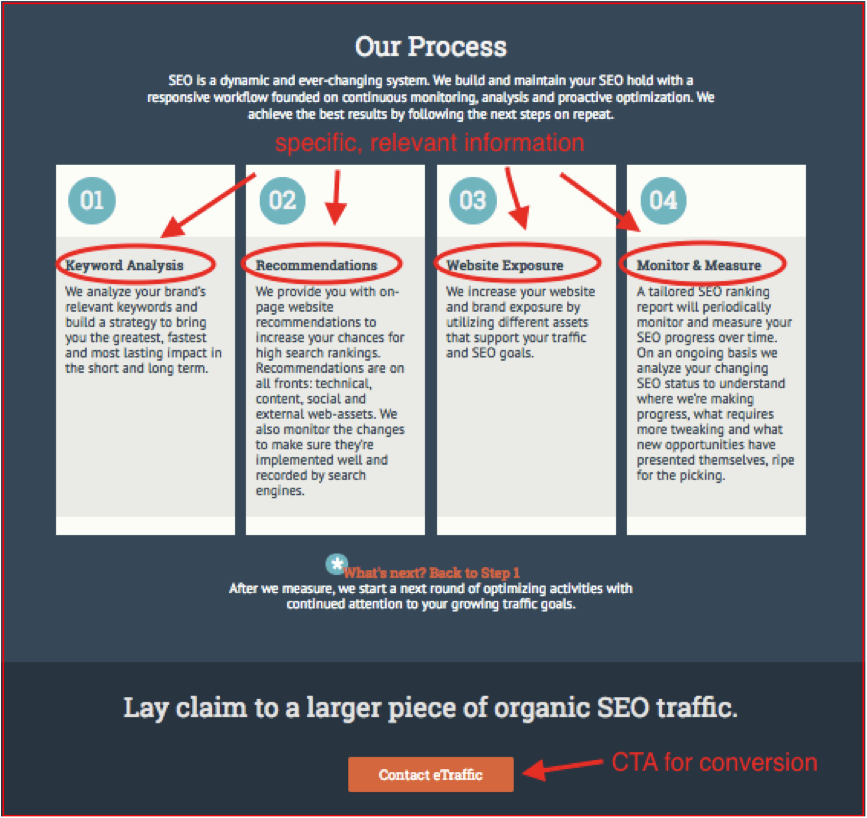
A janitorial services company, product page:
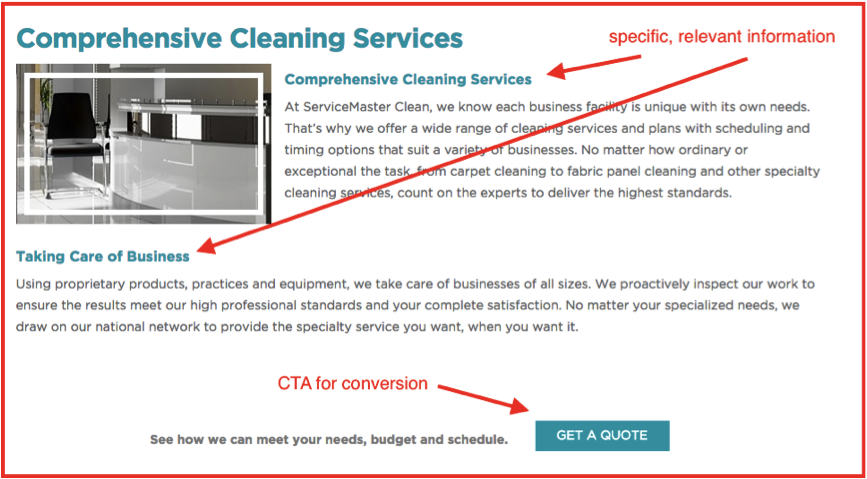
source: servicemasterclean.com
A fire-sprinklers manufacturer, product page:
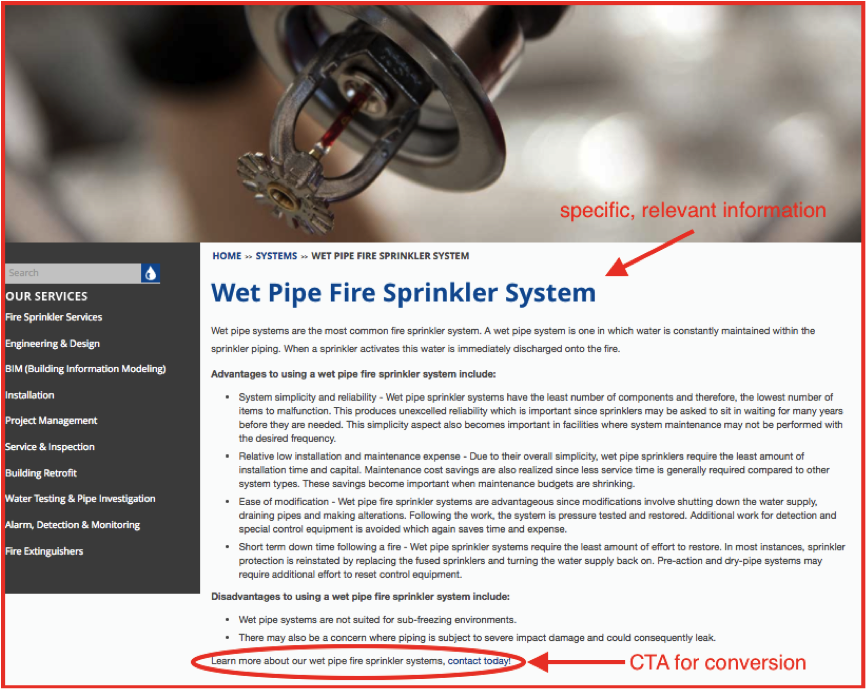
source: vfpfire.com
Blog Pages
Let’s look at a few examples of blog pages, how they
- Enhance brand awareness
- Provide educational information on various topics
From our own blog, a post page:
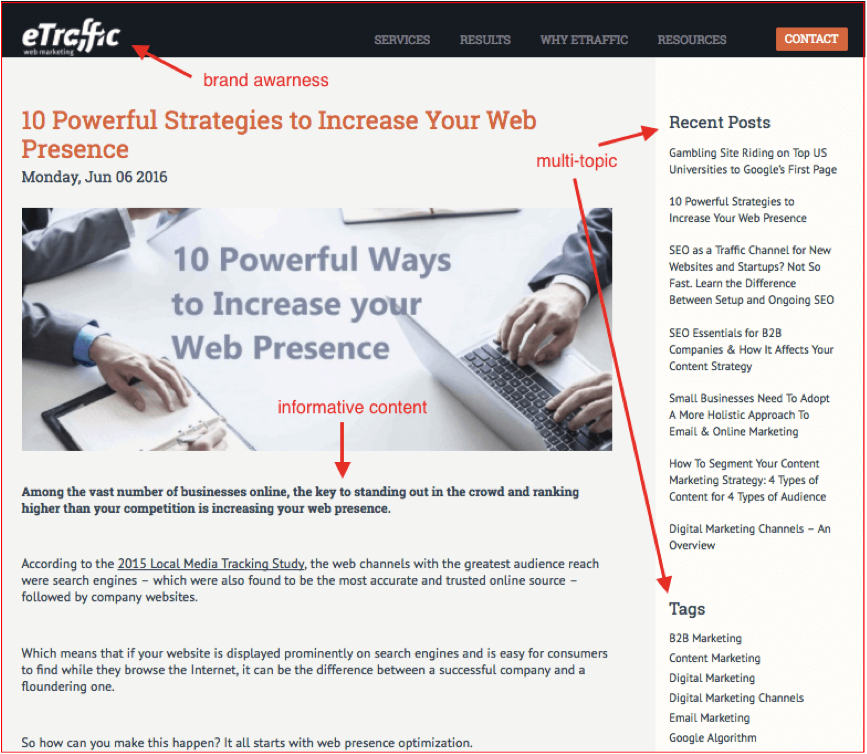
A janitorial services company, blog post:
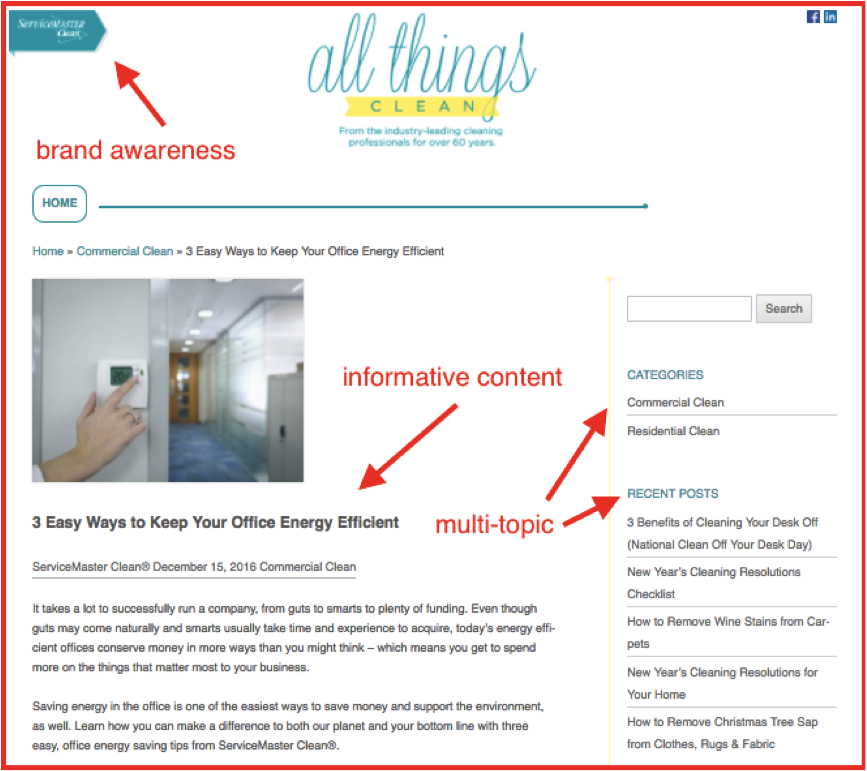
source: servicemasterclean.com
A fire-sprinklers manufacturer, blog post:
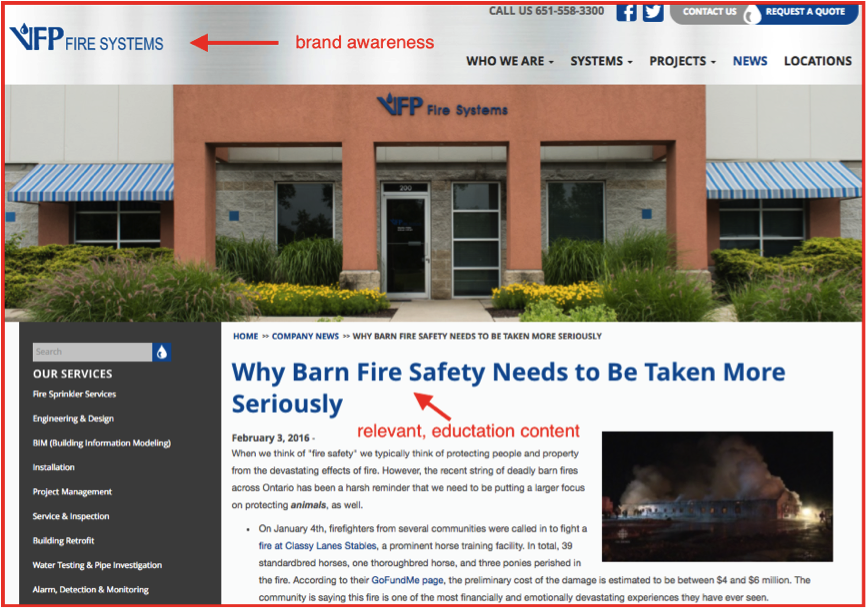
source: vfpfire.com
OPTIMIZING YOUR CONTENT MARKETING
Content is key to a successful SEO strategy.
Every element of every piece of content affects your Google ranking: quality, length, scope, even frequency – if don’t publish any new content on your website for some months, you’ll most likely drop in search engine ranking.
Google has evolved in the way it evaluates content. On top of ‘understanding’ the actual written content, Google takes hints from these factors:
CTR – Click Through Rate
The number of clicks a search result gets relative to its rank.
This tells Google how attractive is the Title and Description of your content.



Make sure both title and description are easily understood and are attractive enough so users would want to click them.
Remember: the search results page is filled with other pieces of content on the exact same topic. You want your result to stand out.
Time On Site
Google judges how interesting and informative your content is by measuring how long users spend reading it. The more time they spend on the page, the more Google will mark it as quality content.
Return to Search Results
Another cue Google takes from the time users spent on a specific piece of content is how relevant it is to the Title and Description.
If Google detects that a high percentage of users who clicked on the result spend very little time on the actual page, it concludes that the content itself doesn’t deliver on the promise of the title and description.
This will result in a drop of your rank in search results.
LINK BUILDING
The crux of an SEO strategy.
Link building is: the process of facilitating the creation of links in third-party websites that point back to your own site and thus boost your web presence.
Link Building Process
- Identifying third-party websites and publications that are relevant to your product or industry and might be interested in publishing your content
- Creating content that fits these sites and embedding links pointing back to your site
- Distributing the content for publication
- Watching incoming traffic to your website in addition to search ranking going up
And repeat.
The Purpose of Link Building
When you publish content on relevant sites, you achieve two goals:
- Drive real, organic, quality traffic to your website
- Improve your site’s ranking with Google and other search engines
Third party sites can be relevant to you on two levels:
- Site level – the site theme or topic falls within the boundaries of your industry
- Page level – the site can be of ‘shoulder-industry’ (industries that relates to yours), but the page is focused and relevant to your industry
Example: For an accounting for SMBs software company:
A site level relevancy would be SMB Nation, a publication devoted to the needs of small and medium businesses.
A page level relevancy would be a publication devoted to stories about unique business endeavors.
Time to switch gears, from Basic to Advance.
HOW TO DEAL WITH LOW SEARCH VOLUME KEYWORDS
Search volume for some of your targeted keywords will be small. Meaning, you’ll find that some of your keywords of interest are searched very few times a month.
The higher the cost of the product, the smaller the search volume for it will be.
Example: the number of searches conducted for a pricing optimization software enterprise level (cost: half a million dollars a year) will be much smaller than the number of searches conducted for a product recommendation plugin (cost: $170).
Another Example: the number of searches per month for a construction crane with a 200’ boom (cost:$1,250,000 – used) are fewer than the number of searches per month for an office water cooler ($870).
The big question is: when is a search volume too small and no longer worth your SEO efforts? It depends on the cost of the product.
Let’s look at that crane again:

source: machinerytrader.com
SEARCH VALUE PROFIT POTENTIAL
The search profit potential of every single search for this crane, or similar cranes, is $1,250,000. So even if there are only a handful of searches a month for this crane, it is worth the effort to target them because of the high price tag.
The higher the cost of the product, the lower the search volume that will be of interest in SEO.
Targeting numerous sets of keywords with low search volume is a core strategy of B2B SEO.
Diversity of Keywords
Your SEO should be mindful of keyword variations – different words that describe the same thing.
The most common example is: software, tool, platform, solution.
All of them mean the same thing more or less, and are used interchangeably. You can choose to target all keywords in your SEO strategy, or to focus on just one or two. It depends on the factors mentioned above.
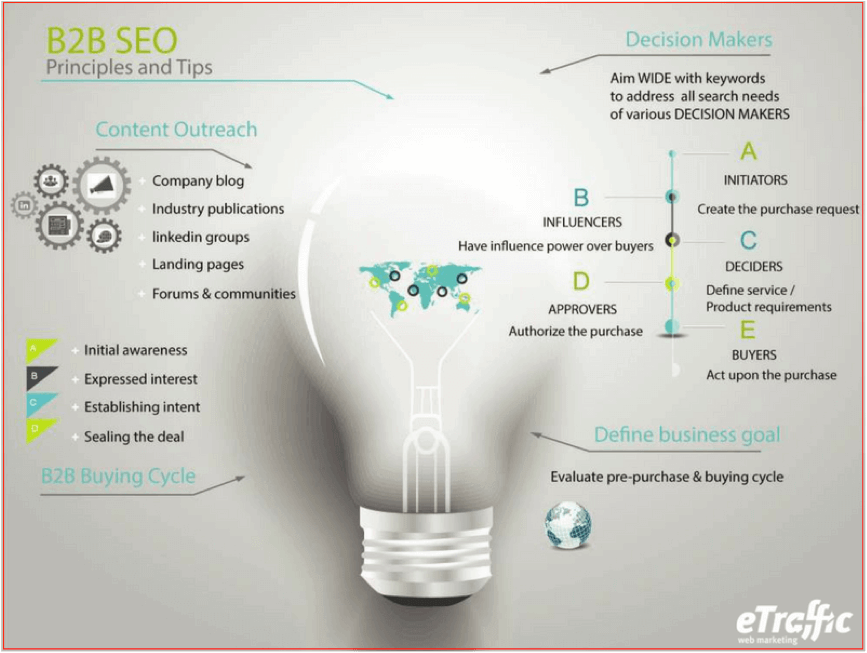
CONTENT DIVERSITY: THE 4 TYPES OF CONTENT
Google also understands content diversity – meaning, whether you present your subject matter from different angles, or keep pounding the same theme over and over again.
That’s why you should personalize your content for different personas and aim to answer all their specific needs; creating and distributing informative and relevant content is one of the key elements of an effective thought leadership marketing campaign.
The challenge is to create quality content that is well researched, written pointedly and presented effectively. Being able to produce such content will greatly benefit your SEO efforts.
Here are the four main types of content for B2B content marketing & SEO:
Conversion-Focused Content for Experts
Content that’s meant to communicate new information about your company, a new product or feature, or an impressive deal – content that’s meant to present you in a favorable light in order to generate leads and drive sales.
Targeting an audience of industry experts and professionals that are familiar with your company/product.
Example: improved services announcement
Here’s one from ZIM, a shipping company:
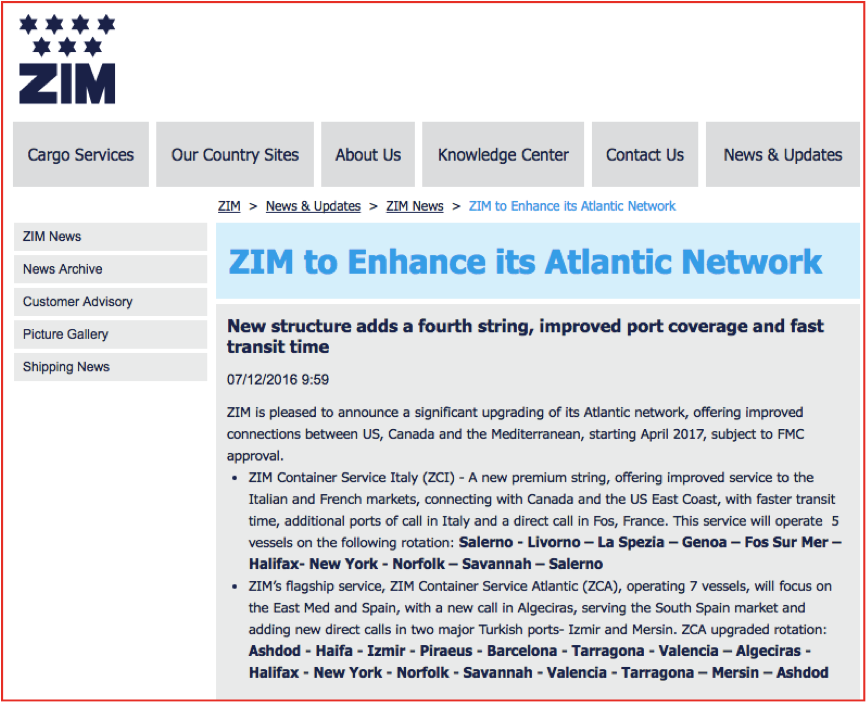
source: zim.com
Self-Promotional Content for Insiders
Informative content that’s meant to highlight your advantages over your competitors, preferably in an indirect manner.
Targeting industry insiders that may have heard of your company/product/service but are not closely familiar with it.
Example: case study that highlights the value your company brings
Here’s one from Infosys:

source: infosys.com
Introductory Content for New Comers
Informative content that’s meant to provide a deeper understanding of your industry, or a specific aspect of it in an introductory manner.
Targeting ‘visitors’ to your industry that are just now demonstrating an interest. This type of content promotes brand awareness.
Example: a basic guide of elementary tips
Here’s one from TradeGecko:
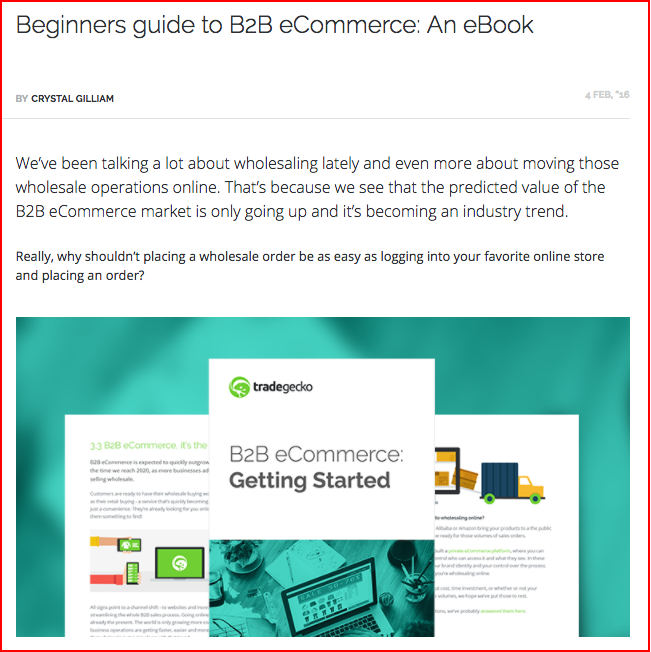
source: tradegecko.com
General Interest Content for Outsiders
Entertaining content that’s meant to explore a ‘shoulder-industry’ and draw prospects into your own industry.
Targeting an audience with low-to-none working knowledge of your industry that never heard of your company/product/service.
Example: newsworthy blog post
Here’s one from our own blog:

To learn more about how to segment your content marketing strategy, read our 4 Types of Content for 4 Types of Audience article.
DISTRIBUTION STRATEGIES
Distribution is: gaining interest by as many sites as possible in your content.
The idea of content distribution is as follows:
Creating unique, high-interest content and publishing it on your own website. Ideally, the content would be of interest to multiple industries.
Then, distributing the content to third-party blogs and publications so they will write about it and link back to your article as the source.
Example: A Map of Every Game of Thrones Filming Location in Real Life – this was actually a real post from a traveling agency. They thought, and they were right, that many sites would be interested in such content, from multiple industries, due to the incredible popularity of the show.
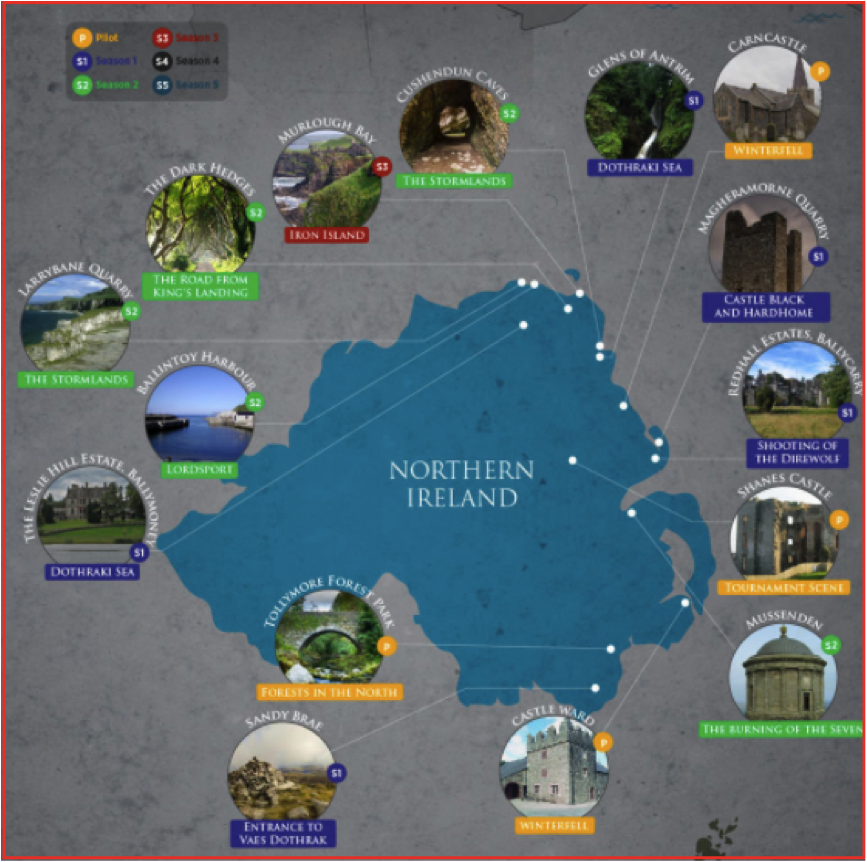
source: lawrenceofmorocco.com
The map was written about and linked back to by more than a hundred different wesbites. Here, now they got yet another link and mention from us.
The other side of content marketing is guest blogging:
Contacting relevant blogs and publications, either of direct industry or shoulder industries, and pitching them an idea for a post to publish on their sites.
You get two benefits from this:
- Brand recognition: if you write original, relevant content, readers could remember your brand, and next time a need arises, they will remember you
- A back link to your website (it is the custom to provide a link in exchange for content.)
TOOLS FOR KEYWORD RESEARCH & RANKING
These are the tools we use for keyword research:
Search Analytics in Google Search Console (previously known as Google Webmaster Tools) tells you which keywords drive traffic to your website, and what other keywords hold the potential to improve their position.
When you plan ahead your strategy, Google Keyword Planner & Ahrefs are great tools.
Here’s a taste from Google Search Console for the traffic generated by various keywords.
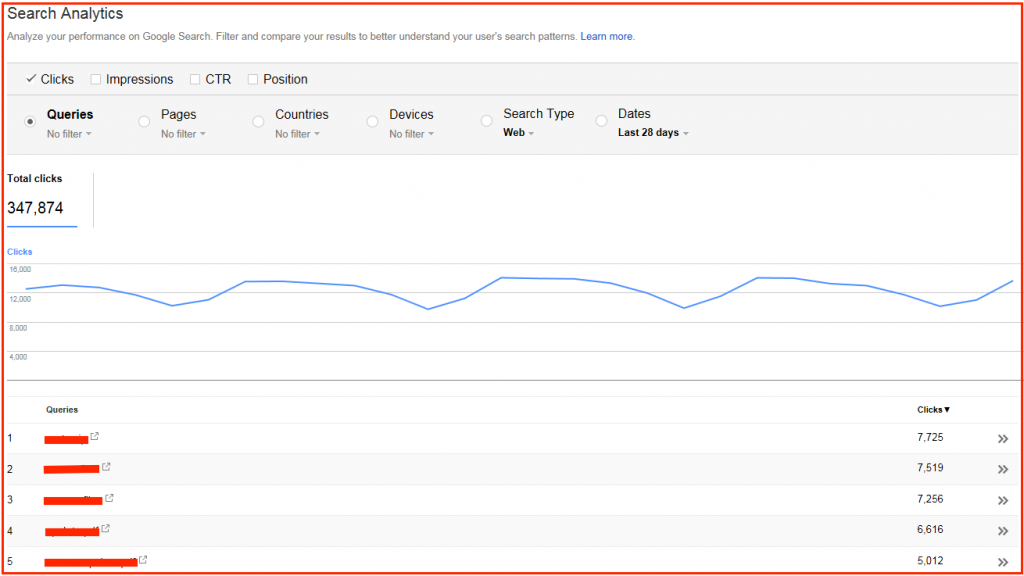 source: Google Search Console
source: Google Search Console
Here’s a taste from Google Keyword Planner for the term “SEO”; on the top we see volume of monthly searches, and at the bottom a breakdown of related terms, such as “SEO services” and “SEO company”:
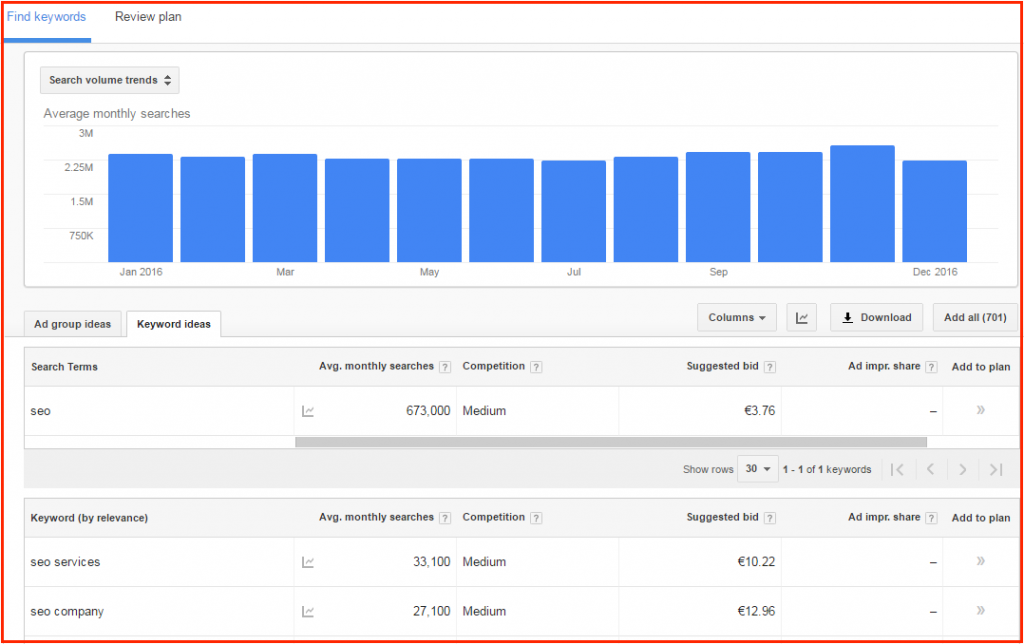
source: Google Keyword Planner
And here’s the same run on Ahrefs, for the term “SEO”:
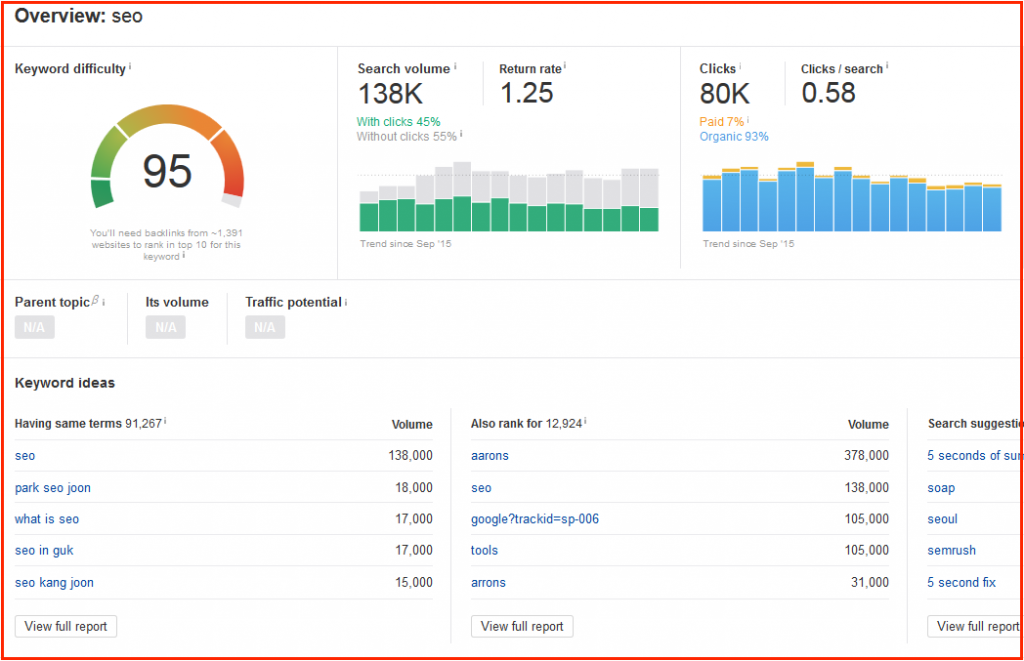
source: Ahrefs
Here are the tools we use for looking into keywords ranking:
Search Console is a free option to use for keyword ranking. It gives general, somewhat vague results.
If you need more precise results, including specific geo-location, use Ahrefs.
Here’s a taste from Ahrefs’ keyword Rank Tracker. We can see the geo-location and rank of various keywords and terms:
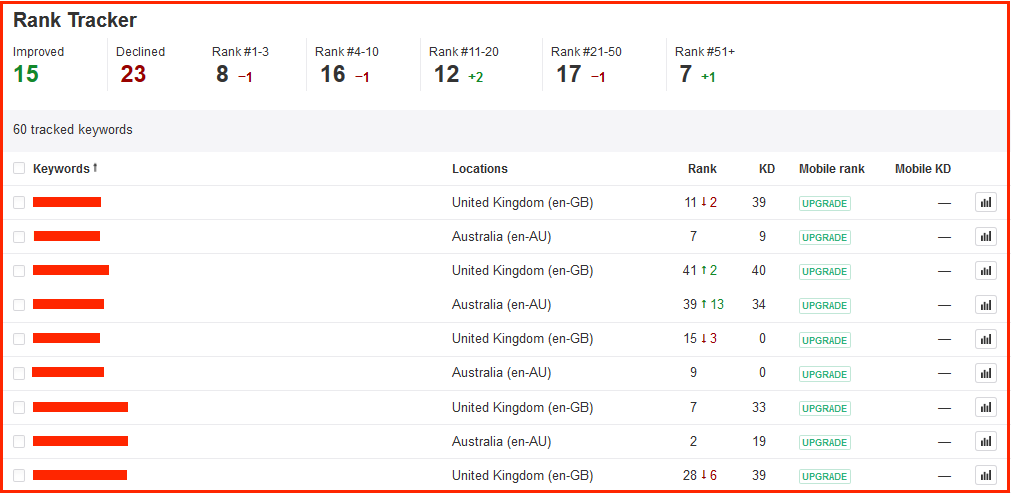
source: Ahrefs
For this purpose also, since we are monitoring thousands of keywords across various geo-locations, we have our own in-house developed tool that allows us to act in a more scalable way.
TOOLS FOR BACKLINK RESEARCH & LINK BUILDING
Here are the tools we use for backlink research and link building:
To monitor your own backlinks (links in third-party sites that point to your website) you need to open an account with Search Console (previously known as Google Webmaster Tools.)
For competitor backlink research we use both Ahrefs and Majestic.
Here’s a taste from Ahrefs, where we can see a rundown of the links pointing to a specific website:
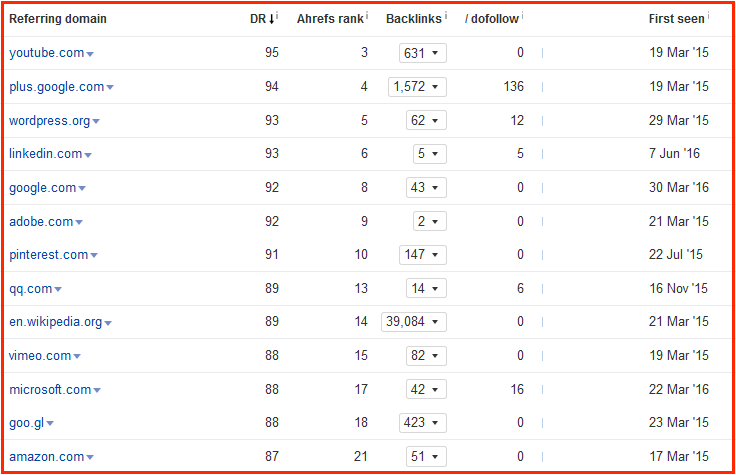
source: Ahrefs
And here’s one from Majestic, where we see different domains and their total backlinks:
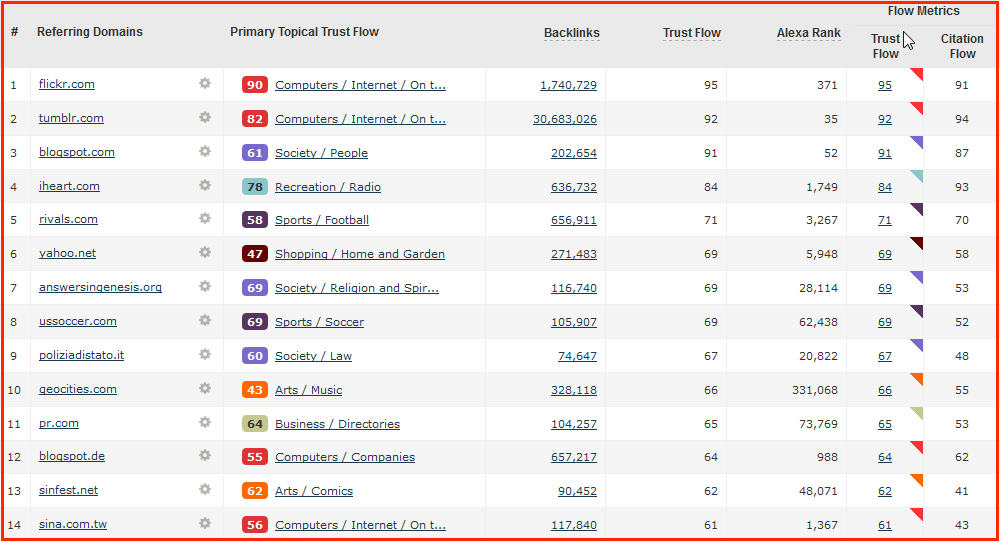
source: Majestic
CONTENT DISTRIBUTION PLATFORMS
Here are the platforms we use for content distribution:
For content distribution we use Inbound.org, GrowthHackers.com and Zest.io, three great content discovery platforms, mostly targeting the marketing industry.
On top of that, since our distribution needs are much more targeted on the one hand and at scale on the other, we developed an in-house tool for segmented content analysis and outreach.
LAST WORDS FROM A B2B SEO AGENCY
Every element of an SEO strategy is crucial to its success. No less important is the ability to seamlessly weave all the various elements into one program. That’s true for basically every process, right?
What separates SEO, and why we love it so much, is it being wholly analytical AND wonderfully creative. There are many ways to attack SEO. We settled, after many years, on a combination of technical SEO based on in-house developed technology for search and analysis and targeted content marketing.
As a B2B SEO agency we need to understand and interpret the Google algorithm to the last tooth and nail, to know the companies we work with in depth, to create killer content while knowing how to distribute it effectively.
by Assaf Dudai, Head of Content and Guy Regev, CEO of eTraffic